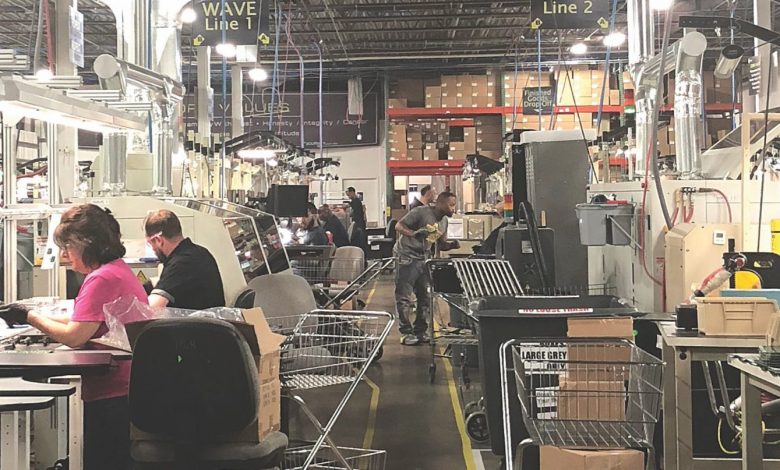Welcome to One Control RVs

Sure, Lippert Components OneControl Smart RV Technology will let the RV’s owner control his lights or awning or a host of other features from a smartphone.
It’s what that owner isn’t necessarily thinking about controlling that will likely provide the greatest benefit to both him and the OEM that made his rig, however. Future possibilities include recognizing that a design or component has a problem – or even being able to order the correct replacement part long before the RV gets pulled into the dealership or service center, according to John Manfreda, a system architect with LCI.
And, it’s all being made possible by a great leap forward in the area of connectivity.
Growing Connectivity
It’s not that the idea of connectivity is new, but how it’s being achieved that continues to grow and expand. For instance, the idea of a home computer being able to connect to the Internet once meant a land-line phone.
In much the same way, remote control – whether at home or in an RV – typically meant operating from a wall-mounted touchscreen.
The touchscreen is still there for those who want it, but for a large segment of RVers, the phone has become the computer, transmission has gone cellular, and stored data has moved into the Cloud. It’s little wonder that OneControl has joined them there.
“We’ve added both Cloud services and cellular services to our offering with our OneControl ConnectAnywhere and OneControl Wireless,” Manfreda says. “It’s a big deal because now we’re talking telematics and telemetry, which means you can do long-distance coach control, voice-activation commands and GPS tracking. It also enables the Cloud presence through the coach.”
In short, it expands the idea of remote control of a coach and turns OneControl into an OnStar-type offering. And, while ConnectAnywhere and wireless are still being offered as options, Brent Hamood, director of sales for OneControl, says the numbers certainly support them soon becoming a standard.
“We expect that next year every car Ford sells will have cellular connectivity,” Hamood says. “AT&T has 24 million cars on their in-car Wi-Fi network and adds about 2 million more every quarter, so that tells us cellular connectivity isn’t going away.”
And, while he adds that the RV industry has traditionally been a bit behind cars and homes in adopting technology, more OEMs will look at it to help differentiate them in the market.
“More people will come to expect this type of service,” Hamood says.
At its simplest, these remote systems have always allowed users to perform tasks such as checking their tank levels before heading off-road to a remote campground. However, with cellular capabilities, they can now turn on the lights and HVAC well before returning from a hike or trip into town.
And, they can do it with the touch of a phone screen – or by voice. LCI added a voice system to OneControl in 2016.
“The cool thing about voice is the adoption rate is actually faster than with cell phones,” says Hamood. “It’s natural for people to interact by speaking, and almost 13 percent of households have a voice system from Amazon or Google.”
“The Millennials absolutely expect it,” adds Manfreda. “Even people in RVs get it. It’s the entryway into digital connectivity; once you get them hooked on voice they want everything else.”
Something for Everyone
What will that “everything else” entail?
The remote-control manufacturer that can answer that best may not currently even be currently in the marketplace, according to Hamood, who adds it could very well be supplied by Google or Amazon.
In the meantime, LCI says the number of items the company’s research-and-development team is looking at encompasses a wide segment of possible products and ideas.
“We’re looking at things like remote door locks, of course,” Hamood says. “Power management, software updates, trip reporting, GPS monitoring, remote diagnostics; we’re working on all those things at once.”
Fortunately, Manfreda adds, LCI has an infrastructure that allows the company to work on those multiple things, and with the system existing in the Cloud, new features don’t have to have simultaneous rollouts and instead can be added as they’re developed.
Still another question that’s yet to be answered is what will the advent of 5G mean for products such as OneControl? Its ability to offer a high data rate, higher system capacity and increased device connectivity might not change the way an RV owner runs out his awnings and slide-outs, but it does have the potential for LCI to offer still more products.
“The tremendous bandwidth may get us into infotainment, where people want to stream videos and movies and that kind of thing,” says Hamood.
“RV owners aren’t camping to get away from technology,” agrees Manfreda. “They’re getting away from the hustle and bustle of daily life, but they still like technology to keep them warm and they still want to surf the web when they’re sitting with their friends. Things like 5G, and cellular hot spots – which are already part of our offering – has its own value.”
And, while areas such as power management and remote diagnostics don’t have the same appeal, perhaps, as the ability to dim the lights at the right moment, that’s where Hamood and Manfreda see tremendous potential with OneControl’s ability to enhance communication to and from the coach.
Putting a bit of a damper on things is recent problems that have arisen between some popular social media sites and users unhappy with the collection and dissemination of personal information. Rather than using what they are learning to sell an RV owner tunics or body wash, the data being collected through OneControl is being used to remotely diagnose issues and – ideally – build-in service improvements.
Hamood compares it to going to an automobile dealership and hooking into a computer that shows the fault codes.
“We’ve built those things into the controls we’re putting in,” Hamood says. “Now, the dealers have the ability to log into those, and we have the ability to log in and we can see problems, oftentimes before the end-user knows there’s a problem.”
One of the next steps, he adds, is developing an automated email system that will tell owners they might, for instance, have a low-voltage issue with a battery that could cause problems.
Improved Service
Nor does Hamood see this data collection ending there. He says a longer-term goal is improving the service warranty experience of the owner in a way that should be a game-changer for OEMs utilizing OneControl and the buyers of their units.
“We know that’s a struggle for the RV industry,” he says. “Dealers will tell you they have a hard time getting techs who are qualified. We would like to be able to know what’s wrong with a unit long before it gets to the dealership. If we can know what happened, we can have a part shipped to a dealer so it can be there to meet the customer and drastically cut down on service times.”
A secondary benefit Hamood sees is that it will help the manufacturers that supply the industry, including LCI, which is known for items such as axles, awnings and slide-outs.
“We like to think we understand our products very well, but this gives us the opportunity to known them on a different level and improve them,” he adds. “That’s what we’re looking at every single day.”
The goal of improving service times is getting a lot of buy-in from the OEMs, according to Hamood. While those companies realize the RV owner doesn’t mind showing off the ability of his phone to operate his slide-outs, they, too, want to improve service times at their dealerships.
The data also helps RV manufacturers understand how their customers are using their units in the field, and LCI is taking requests from OEMs that want to know different types of information of that nature – a process that’s helped by the fact that OneControl operates out of Sterling Heights, Mich., and is manufactured in the United States.
Manfreda says only recently did LCI turn up a case where monitoring fault codes showed that one OEM was having issues with a component LCI was providing – a first for the company.
“Normally, the owner might have had a problem for the life of the vehicle and not known it,” Manfreda says. “Or, they might have blown more fuses and it would be annoying. But, through the Cloud we were able to contact this manufacturer and have them reconfigure how they were installing the piece on the assembly line.”
Of course, LCI will continue to investigate more ways to connect and monitor the various components that go into an RV, but the possibilities go well beyond that. Not only will all RVs have a cellular connection, but it will be necessary to service the younger Millennial buyers.
“Their expectation of service is much different than in the past,” Hamood observes. “They’re used to things fixing themselves in the moment and moving on, and as their expectations grow, we just get better at providing that.”
How much better?
“We’re going to be building better, smarter RVs from an OEM perspective, and we’re going to be building better, smarter components from a supplier perspective,” Hamood says. “And, the market is going to be much better in terms of consumer confidence because we’ll have a tremendous idea of what’s gone wrong and why it’s gone wrong and how to fix it really quickly.”


